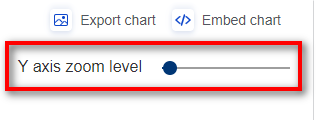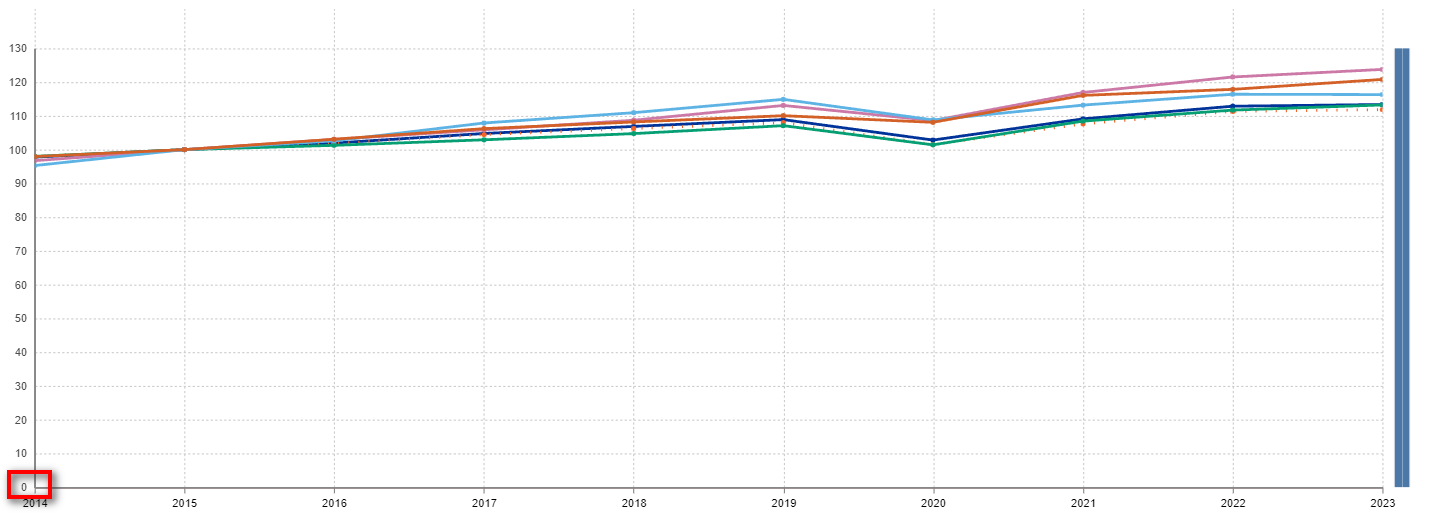How to manage line charts
In the data display panel, click on the tab 'Line'

Basic functionalities
- mouse over a line, for example Germany, and a so-called tooltip with information appears on top

- click on a label of an item of the series below the line chart to highlight its line in the chart area above and keep it highlighted when moving your mouse over the line chart

- zoom in on the X-axis by clicking on a point in the small legend below the line chart and drag it to the right or to the left until the end point you wish to zoom in on, the view in the line chart will adjust to your selection and the area that is zoomed in is highlighted in the bottom legend

- zoom in on the Y-axis by using the Y-axis zoom level located towards the upper right-hand side in the chart. Move this selector to the right side of the slider increases the Y-Axis zoom level, up to 4 time. When the zoom level is increased, a vertical scrollbar appears. This scrollbar provides the vertical movement throughout the zoomed line chart.

Layout and display of dimensions
You can customise what is shown in the bar chart in the data selection panel:

The X-axis dimension displays horizontally at the bottom of the line chart, in this example it is the years (Time dimension).
The series is displays available as a legend below the chart, in this example it is the geopolitical entities (countries). The elements of the legend depend on the data displayed option.
The combination of dimensions are the data value(s) represented in form of the line, in this example GDP in million euro.
Please note: It is not possible to display more than 24 lines in the chart.
Highlight option
Click on the button 'Highlight' to refine the display of your chart. This is located on the upper right-hand side of the line chart.

Clicking on the 'Highlight' button will show a list with the current selection of positions. In that list you can select or deselect positions using the selector field in front. The chart is refreshed automatically to allow you to preview the change.
Please note: only positions that are selected as being highlighted are shown in the line chart. It might occur that when you open a dataset and select the line chart display, no position is highlighted. In this case, the following information message is displayed:

In case the line chart visualisation is accessed while there is no highlighted positions, the following rule will apply to ensure a baseline chart is rendered:
- In case of a non-geopolitical entity (GEO) dimension, the data series with the highest value in the most recent time period is displayed. Thus, the line chart shows only this 1 series.
- For a GEO dimension and in case EU or euro area aggregates (EA) are present in the selection, the most relevant EU and EA aggregates are displayed. Thus, the line chart shows 2 series.
- For a GEO dimension and in case no EU or EA aggregates are present in the selection, the data series with the highest value in the most recent time period is displayed. Thus, the line chart shows only this 1 series.
This is necessary so that at least 1 line can be rendered by default and the line chart does not appear empty.
Format options
Click on the button 'Format options' to refine the display of your line chart. This is located on the upper right-hand side of the line chart.

When you click on this button, a pop-up window will appear with multiple tabs for customisation of the line chart:

General options
For information on the general options, please consult our page on how to use the format options. Please note - as displayed in the information message in this pop-up window - that the options you select under 'General options' apply to spreadsheets only. For other formats, such as CSV or SDMX, please refine your selection in the advanced settings available via the 'Download' button.
Specific options
For the line chart, you have 2 tabs with the following specific options:

Line options
Under this tab, you have the following options:
- Show series markers: by default, this is activated, meaning the markers on the line chart are displayed. By markers, we mean the little dots that appear on the line. If you click in the box to remove the tick, these markers will disappear.

- Vertical axis (scale): by default, the option 'start from 0' is selected. This means that the chart starts from 0 on the vertical axis (y-axis).

If you change this and select 'automatic', the scale on the y-axis will be automatically computed to optimise the view of the line chart and it will adapt to the range of the data values.

Data displayed
Under this tab, you have the option to customise the data displayed and the data labels.
The highlighted mode allows the chart to display only the positions currently highlighted. The highlighting needs to be done via the 'Highlight' button, located on the right-hand side above the line chart next to the 'Format options' button.
The summary mode allows the chart to display a summary version of the selected data. It is built on the following principles:Among the selected positions, the following positions are the only ones displayed in the chart:
- top 3 lines, these are those for which the last data value are highest
- 3 average middle lines
- bottom 3 lines, those for which the last value are the lowest
All the other lines are hidden in the chart.
Lines corresponding to positions for which no statistical data is available will not be taken into account.
The selected mode allows the chart to display all the positions from the selection into the chart.
Lines are either rendered as grey line if they are not selected, or coloured if they are highlighted. Clicking on a line or a legend element allows to highlight or unhighlight it.
For the show data labels, the option 'none' is selected by default.
Export, embed, and print
These functionalities are located on the top right-hand side of the line chart

Export chart
When clicking on 'Export chart', a pop-up will appear:

In the drop-down field, different file formats are available for the export:
- image in png format (png stands for 'Portable Network Graphics')
- PDF document (PDF stands for 'Portable Document Format')
- svg vector image (SVG stands for 'Scalable Vector Graphics')
In addition, you need to decide on the chart elements to display:
- title: meaning the title of the dataset you are using
- dimensions and positions summary: meaning the selection you have done in the data selection panel, for example the year and unit of measurement, which will be displayed a subtitle
- context: meaning information on the source, dataset title and code, last update date of dataset, disclaimer
- legend: the name and colour coding for each series, meaning line chart. In the example further above, it is the legend of the names of the geopolitical entities (countries) and their colour.
All 4 options are ticked by default. Once you have made your selections, please click on 'Generate file' and check your downloads.
Embed chart
When clicking on 'Embed chart', a pop-up will appear

Click on the button 'Copy' located on the right-hand side of the embed code. This will automatically select all the code and copy it into the clipboard. A success message will also appear to inform you about this. If this message does not appear, it means the code has not been copied. In this case, you can also manually select the embed code with your mouse and use the copy and paste functionality of your keyboard.

Print chart
You can also choose to print the bar chart using the built-in print functionality of your browser. This can normally be accessed with the keyboard combination CRTL+P, meaning to press simultaneously the control button and the letter P. Alternatively, you can also open the browser settings and select 'Print' in the list.
If available in your browser's print dialog box, make sure to adjust the print settings in a way that the full bar chart will be displayed, for example the orientation and scale.
